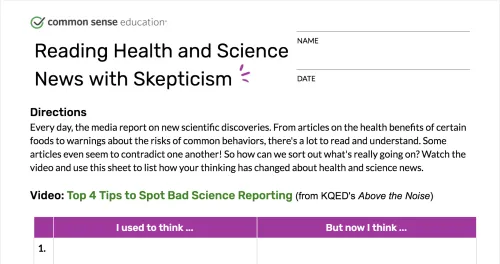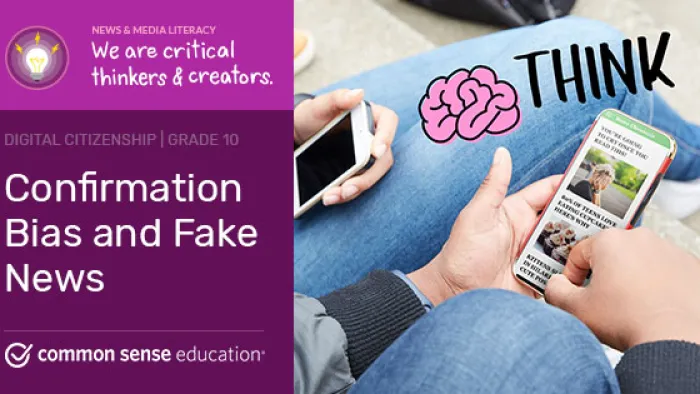Use this lesson plan to help your students read beyond the headlines about scientific studies.

New scientific research happens all the time. And it seems like every day there’s a story in the media about a stunning new discovery in the worlds of science and health. But whether it's the latest research on COVID-19 vaccines or a study about the effects of screen time on kids, not all media report on science and health news in the same ways.
For example, where one headline may tout the health benefits of coffee, another paints a much different picture. It’s hard to figure out what’s really going on, especially for kids. So how can we help students learn who and what to trust? Especially when it's so easy to believe headlines we agree with, regardless of what the research might say.
Use this activity to help students approach what they’re seeing in the media with a skeptical lens. From recognizing how headlines shape the way we interpret science- and health-related news to digging into actual research studies, you’ll boost your students’ health and science news literacy.
Recommended for:
Grades: 8-12
Subjects: ELA, science, newspaper/media, digital citizenship
Prep for teachers
- Preview the video, "Top 4 Tips to Spot Bad Science Reporting" from KQED’s Above the Noise, and look over the discussion questions.
- Make a copy of the "Reading Health and Science News With Skepticism" Google Doc handout. (Tip: Before distributing to your students, customize the handout to your class' needs.)
- Review the “I used to think …, But now I think...” thinking routine from Project Zero’s Visible Thinking website.
In the classroom
Hook (5-10 minutes):
Before screening the video, ask your class if they’ve noticed any recent scientific studies reported in the news. Because information about the COVID-19 pandemic will likely be dominating the news, they’ll probably bring this up. But challenge students to think about news related to scientific research (this could be about COVID-19 or otherwise).
What have they heard, and what do they think? Have they ever seen different articles that seemed to contradict each other? After a few minutes, point out that it seems like every week there’s some sort of new scientific revelation about health. From nutrition to screen time to exercise or caffeine – you name it, it's out there.
Distribute copies of the worksheet and ask students to use it to take notes. Explain that they can answer the questions “I used to think …, But, now I think...” at any point during and/or after viewing the video.

Show the video: "Top 4 Tips fo Spot Bad Science Reporting" from KQED's Above the Noise.
Pressing play on the YouTube video will set third-party cookies controlled by Google if you are logged in to Chrome. See Google's cookie information for details.
Discussion (15 minutes)
Start off by asking students to share what they wrote down on the, "Reading Health and Science News With Skepticism" worksheet. Continue the discussion using any or all of the questions and prompts below:
- What is “clickbait”? As a class, come up with a definition for the term, and then ask students to share examples that they’ve noticed recently.
- KQED's Above the Noise created the GLAD acronym to help spot questionable science news. What are the different GLAD tips? Do you think these tips will be useful in considering science reporting in the news?
- When it comes to lifestyle choices, like eating or exercise, how could science news reporting impact people’s actual behavior?
- What is a “peer reviewed science journal”? What makes peer-reviewed research different from other research and studies?
- Is it useful to be skeptical about certain studies? What’s the difference between questioning an issue with scientific consensus like climate change or vaccinations, versus doubting a single, isolated study?
- What are some of the problems that come up when people share questionable scientific studies on social media?
Possible follow-ups:
- Read and discuss the article, "What Skepticism Reveals About Science" from Scientific American about the scientific method, skepticism, and the search for truth.
- Ask students to bring in examples of science reporting headlines that they find in order to follow-up with a classwide sharing activity and analysis. Provide students with another tool -- the CRAAP test -- in order to help them evaluate news sources. Using the examples they found, have students complete an analysis based on either KQED’s GLAD tips, and/or the CRAAP test.
Looking for COVID-19-specific news and media literacy resources?
- Visit the News Literacy Project's COVID-19 misinformation page.
- Misinformation expert Mick Caulfield is hosting the webpage, Sifting Through the Coronavirus Pandemic.
- Subscribe to the News Literacy Project's The Sift newsletter.








